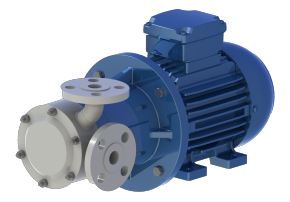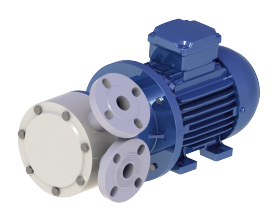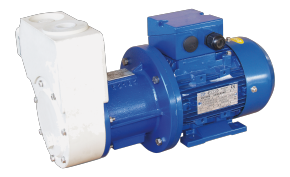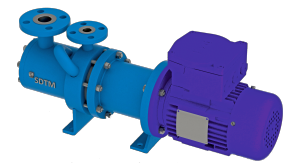Turbine Pumps Explained
Malcolm Walker, Centrifugal Product Manager for AxFlow UK takes a practical look at turbine pumps, how they work, their pros, cons and what they offer the process engineer.
Of all the liquid pump types used in process and off shore applications, turbine pumps are perhaps the least well known. As a result of this general ignorance, turbine pumps present a vastly underutilised solution in our liquid engineering toolbox.
What Are They
One of the main reasons for the general ignorance of turbine pumps is caused by the fact that they fall between two stalls, being something of a hybrid sharing characteristics akin to both centrifugal and positive displacement pumps. This difficulty of definition has left them as outsiders from both the Centrifugal and Positive Displacement Camps - the "Billy No Mates" of the pump world. We can't even agree on their name, variously describing them as turbine, peripheral turbine, regenerative turbine or even centrifugal.
As a consequence we don't use them because we don't understand them, which is a shame as they are in fact quite straightforward and have plenty of advantages. Their basic operational principle is simple, working in a way that many of us believed a pump functioned before we were initiated into the mysteries of radial flow centrifugal pumps. Simply put; in the centre of the pump chamber is a turbine containing multiple buckets around it's "periphery". These buckets carry the liquid round the chamber until it has to leave the pump at the "shut-off" point, making turbine pumps not dissimilar to an enclosed water wheel. The only slight complication occurs as the result of the liquid recirculating within the buckets as the turbine rotates. This constant circular "regeneration" of velocity produces increasing pressures, pressures that far surpass that of a radial flow centrifugal pump impeller with the same diameter.
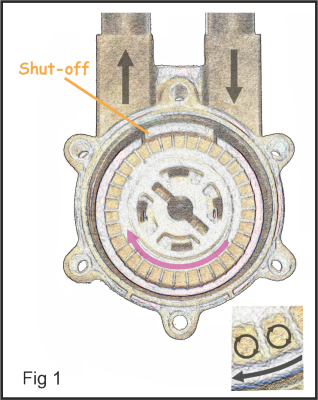
Importantly there is no contact between the turbine's surfaces and the pump chamber being separated as they are by a thin film of liquid on their faces and outer edge at the shut-off point. This means that the liquid isn't completely trapped and therefore turbine pumps are deemed to be using kinetic energy to shift the liquid and not "displacing" a fixed volume. Of course the key word here is "completely" as a thin film of liquid isn't very much and consequently nearly all of their characteristics are those of a positive displacement pump.
Characteristics
In practice, turbine pumps behave pretty much like positive displacement pumps and don't share much in common with their Kinetic pump brethren. Most notably they differ from most centrifugal pumps as:
1. They have straight differential head – flow curves.
2. Power increases with pressure not flow.
3. They can handle viscous liquids better while being good with thin liquids.
4. Their pump action is relatively low shear.
5. They can pump liquids with up to 20% entrained gases.
6. With no axial thrust loads they have lower NPSH requirements as much less damage is caused in such situations.
7. However, they're not so good with solids.
8. You wouldn't normally use them to deliver large volumes of liquid against a low head.
9. And lastly, don't fit them in an attack submarine as a high frequency vibration occurs every time a bucket passes the shut-off.
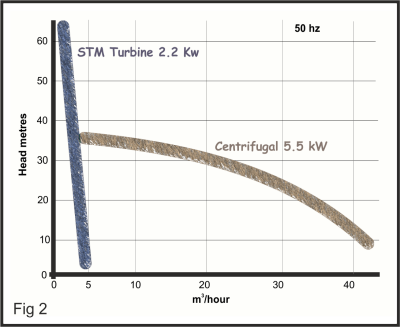
When Should I Consider Them
At Axflow we supply several ranges of turbine pump and have found a multitude of applications for them. These applications stem from either their hydraulic characteristics or their construction and how it lends itself to certain configurations, materials and finishes.
Low Flow – High Head
The main use for turbine pumps comes from their low flow high head capability demonstrated by fig 2 which compares a single stage ISO 2858 centrifugal curve with that of a turbine pump. The centrifugal pump is fitted with a 5.5 kW motor and the turbine a 2.2kW. It's pretty clear where the turbine pump excels.
But what about multistage centrifugal pumps? Well, the truth is that if you can use a mass produced multistage centrifugal pump then it will invariably be less expensive. However, if there's anything slightly unusual about the applications be it a chemically aggressive liquid, an ATEX zone or high liquid temperature then a turbine pump will be better.
Difficult Liquids
All of our turbine pumps are magnetically driven and are available in polypropylene, PVDF, 316 SS and Hastelloy which makes them chemically resistant but it's their low shear capabilities and similarly to PD pumps which brings the greatest advantages. For instance, one of the biggest uses of turbine pumps was in pubs when thousands of turbine pumps up and down the country delivered beer from the cellars to the bar without thrashing it into undrinkable foam for decades before the advent of cheaper gas pumps. Turbine pumps will handle viscous liquids up to 150 cP, in fact they prefer viscous liquids as they become more efficient. This makes them good with caustic solutions as their flow fluctuates a great deal less than a centrifugal pump if the caustic is subject to varying temperatures. Lastly, their ability to cope with 20% entrained gas makes then very useful in situations involving turbulent flow and they can even be used to mix separate streams of liquid and gas together.
Technical Requirements
All of our turbine pumps, including the plastic and self-priming ranges, can be ATEX complaint. The STM range can be constructed from all manner of metals including Duplex, Hastelloy and Titanium and can therefore withstand system pressures of up to 350 bar. High temperatures can be accommodated with long coupled models being able to handle liquids of up to 350 oC. They are available with self-priming chambers, can be configured to API 685, have polished internal surfaces and come with a range of connection types including tri-clamps.
Where Do Other People Use Them
Although less well known than other pump types turbine pumps have been in use for decades. The most well know is as vertical multi-stage pumps in the municipal water and off shore sectors pumping water at very high heads, but their use is much more widespread. They can be found cooling all manner of equipment from x-ray machines to VSD assemblies, CIP duties, the transfer of small flows over long distances, as tanker off-loading pumps, vapour recovery systems, filter systems where higher pressures are encountered, spray bar applications, soda re-circulation in many fast food outlets, shower booster pumps, LPG distribution the list is almost endless. So, too are the industries in which turbine pumps can be found including petrochemical, pharmaceutical, food production and food dispense, medical, laboratory, military, nuclear generation and general chemical.
All in all we've found turbine pumps an extremely simple solution to a host of low flow and tricky pumping challenges. We are firmly of the opinion that their use should be more widespread and would be if engineers were only willing to look just outside of their comfort zone more often.

